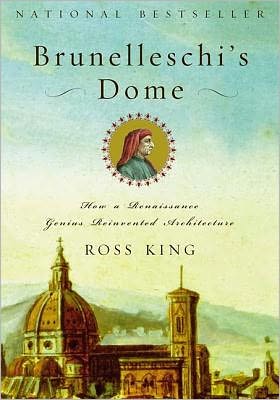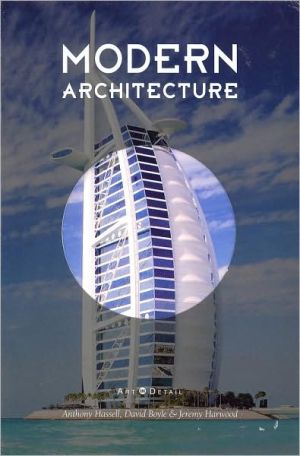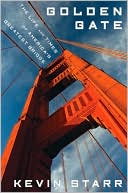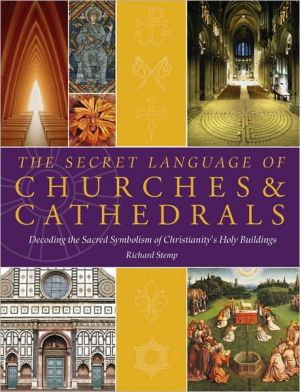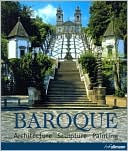Brunelleschi's Dome: How a Renaissance Genius Reinvented Architecture
Even in an age of skyscrapers and sports stadiums, the cathedral of Santa Maria del Fiore in Florence, with its immense dome, retains a rare power to astonish. Yet, for more than a century after work began on the cathedral in 1296, the proposed dome was regarded as impossible to build. It became the greatest architectural puzzle of the age, and when finally complete in 1436, was hailed as one of the wonders of the world. Ross King tells the full story of how the cupola was raised, from...
Search in google:
Describes how a fifteenth-century goldsmith and clockmaker, Filippo Brunelleschi, came up with a unique design for the dome to crown Florence's magnificent new cathedral, Santa Maria del Fiore.Los Angeles Times - Merle RubinThere's an art to writing about how things work, and, in the tradition of Henry Petroski and Tracy Kidder, Ross King has a knack for explaining complicated processes in a manner that is not only lucid but downright intriguing. In addition to his fascinating descriptions of Brunelleschi's inventions and methods, King fills in the equally fascinating biographical and historical background. We get a good sense of Brunelleschi's peppery personality (he enjoyed devising elaborate, rather spiteful, practical jokes), his rivalry with the sculptor Lorenzo Ghiberti and the exciting, tumultuous world of the quattrocento Florentine republic.
Chapter 1: A More Beautiful and Honourable Temple\ On August 19, 1418, a competition was announced in Florence, where the city's magnificent new cathedral, Santa Maria del Fiore, had been under construction for more than a century:\ \ Whoever desires to make any model or design for the vaulting of the main Dome of the Cathedral under construction by the Opera del Duomo-for armature, scaffold or other thing, or any lifting device pertaining to the construction and perfection of said cupola or vault-shall do so before the end of the month of September. If the model be used he shall be entitled to a payment of 200 gold Florins.\ \ Two hundred florins was a good deal of money-more than a skilled craftsman could earn in two years of work-and so the competition attracted the attention of carpenters, masons, and cabinetmakers from all across Tuscany. They had six weeks to build their models, draw their designs, or simply make suggestions how the dome of the cathedral might be built. Their proposals were intended to solve a variety of problems, including how a temporary wooden support network could be constructed to hold the dome's masonry in place, and how sandstone and marble blocks each weighing several tons might be raised to its top. The Opera del Duomo-the office of works in charge of the cathedral-reassured all prospective competitors that their efforts would receive "a friendly and trustworthy audience."\ \ Already at work on the building site, which sprawled through the heart of Florence, were scores of other craftsmen: carters, bricklayers, leadbeaters, even cooks and men whose job it was to sell wine to the workers on their lunch breaks. From the piazza surrounding the cathedral the men could be seen carting bags of sand and lime, or else clambering about on wooden scaffolds and wickerwork platforms that rose above the neighboring rooftops like a great, untidy bird's nest. Nearby, a forge for repairing their tools belched clouds of black smoke into the sky, and from dawn to dusk the air rang with the blows of the blacksmith's hammer and with the rumble of oxcarts and the shouting of orders.\ \ Florence in the early 1400s still retained a rural aspect. Wheat fields, orchards, and vineyards could be found inside its walls, while flocks of sheep were driven bleating through the streets to the market near the Baptistery of San Giovanni. But the city also had a population of 50,000, roughly the same as London's, and the new cathedral was intended to reflect its importance as a large and powerful mercantile city. Florence had become one of the most prosperous cities in Europe. Much of its wealth came from the wool industry started by the Umiliati monks soon after their arrival in the city in 1239. Bales of English wool-the finest in the world-were brought from monasteries in the Cotswolds to be washed in the river Arno, combed, spun into yarn, woven on wooden looms, then dyed beautiful colors: vermilion, made from cinnabar gathered on the shores of the Red Sea, or a brilliant yellow procured from the crocuses growing in meadows near the hilltop town of San Gimignano. The result was the most expensive and most sought-after cloth in Europe.\ \ Because of this prosperity, Florence had undergone a building boom during the 1300s the like of which had not been seen in Italy since the time of the ancient Romans. Quarries of golden-brown sandstone were opened inside the city walls; sand from the river Arno, dredged and filtered after every flood, was used in the making of mortar, and gravel was harvested from the riverbed to fill in the walls of the dozens of new buildings that had begun springing up all over the city. These included churches, monasteries, and private palaces, as well as monumental structures such as a new ring of defensive walls to protect the city from invaders. Standing 20 feet high and running five miles in circumference, these fortifications, not finished until 1340, took more than fifty years to build. An imposing new town hall, the Palazzo Vecchio, had also been constructed, complete with a bell tower that stood more than 300 feet high. Another impressive tower was the cathedral's 280-foot campanile, with its bas-reliefs and multicolored encrustations of marble. Designed by the painter Giotto, it had been completed in 1359, after more than two decades of work.\ \ Yet by 1418 what was by far the grandest building project in Florence had still to be completed. A replacement for the ancient and dilapidated church of Santa Reparata, the new cathedral of Santa Maria del Fiore was intended to be one of the largest in Christendom. Entire forests had been requisitioned to provide timber for it, and huge slabs of marble were being transported along the Arno on flotillas of boats. From the outset its construction had as much to do with civic pride as religious faith: the cathedral was to be built, the Commune of Florence had stipulated, with the greatest lavishness and magnificence possible, and once completed it was to be "a more beautiful and honourable temple than any in any other part of Tuscany." But it was clear that the builders faced major obstacles, and the closer the cathedral came to completion, the more difficult their task would become.\ \ The way forward should have been clear enough. For the past fifty years the south aisle of the unfinished cathedral had housed a thirty-foot-long scale model of the structure, in effect an artist's impression of what the cathedral should look like once finished. The problem was that the model included an enormous dome-a dome that, if built, would be the highest and widest vault ever raised. And for fifty years it had been obvious that no one in Florence-or anywhere in Italy, for that matter-had any clear idea how to construct it. The unbuilt dome of Santa Maria del Fiore had therefore become the greatest architectural puzzle of the age. Many experts considered its erection an impossible feat. Even the original planners of the dome had been unable to advise how their project might be completed: they merely expressed a touching faith that at some point in the future God might provide a solution, and architects with a more advanced knowledge would be found.\ \ The foundation stone for the new cathedral had been laid in 1296. The designer and original architect was a master mason named Arnolfo di Cambio, the builder of both the Palazzo Vecchio and the city's massive new fortifications. Although Arnolfo died soon after construction began, the masons forged on, and over the next few decades a whole section of Florence was razed to make way for the new building. Santa Reparata and another ancient church, San Michele Visdomini, were both demolished, and the inhabitants of the surrounding district were displaced from their homes. Not only the living were evicted: in order to open a piazza in front of the church, the bones of long-dead Florentines were exhumed from their graves surrounding the Baptistery of San Giovanni, which stood a few feet to the west of the building site. In 1339 one of the streets south of the cathedral, the Corso degli Adamari (now the Via dei Calzaiuoli) was\ lowered so that the cathedral's height should appear even more impressive to anyone approaching from that direction.\ \ But as Santa Maria del Fiore grew steadily larger, Florence was shrinking. In the autumn of 1347 the Genoese fleet returned to Italy, carrying in its holds not only spices from India but also the Asian black rat, carrier of the Black Death. As much as four-fifths of the population of Florence were to die over the next twelve months, so depopulating the city that Tartar and Circassian slaves were imported to ease the labor shortages. As late as 1355, therefore, nothing existed of the cathedral except for the facade and the walls of the nave. The interior of the church lay open to the elements, like a ruin, and the foundations for the unbuilt east end had been exposed for so long that one of the streets east of the cathedral was known as Lungo di Fondamenti, or "Along the Foundations."\ \ Over the next decade, however, as the city gradually recovered, work on the cathedral accelerated, and by 1366 the nave had been vaulted and the east end of the church, which included the dome, was ready to be planned. Arnolfo di Cambio had undoubtedly envisioned a dome for the church, but there is no surviving evidence of his original design: sometime in the fourteenth century his model of the cathedral collapsed under its own weight-an ominous sign-and was subsequently lost or demolished. But excavations during the 1970s uncovered the foundations for a dome that was intended to have a span of 62 braccia, or 119 feet (a Florentine braccia being 23 inches, roughly the length of a man's arm).1 With this diameter the cupola of Santa Maria del Fiore would have exceeded by some 12 feet the span of the dome of the world's most spectacular church, Santa Sophia in Constantinople, which had been built 900 years earlier by the emperor Justinian.\ \ Since the 1330s responsibility for building and funding the cathedral had been in the hands of Florence's largest, wealthiest and most powerful guild, the Wool Merchants, who administered the Opera del Duomo. None of the wardens running the Opera knew the first thing about building churches: their business was wool, not architecture. It therefore fell to them to appoint someone who did understand the craft, an architect-in-chief, or capomaestro, who would create the models and designs for the cathedral and also deal with the masons and other builders involved in the actual construction. In 1366, as planning reached its crucial stage, the capomaestro of Santa Maria del Fiore was a man named Giovanni di Lapo Ghini. At the request of the Opera, Giovanni began building a model for the cathedral's dome. But the wardens also ordered a second model from a group of artists and masons led by another master mason, Neri di Fioravanti.2 The fate of Santa Maria del Fiore was about to undergo a radical change.\ \ Competition between architects was an old and honored custom. Patrons had been making architects compete against one another for their commissions since at least 448 b.c., when the Council of Athens held a public competition for the war memorial it planned to build on the Acropolis. Under these circumstances, it was normal practice for architects to produce models as a means of convincing patrons or panels of judges of the virtues of their particular designs. Made from wood, stone, brick, or even clay or wax, such models allowed the patrons to visualize the dimensions and decorations of the end product much more easily than would a diagram executed on parchment. They were often large and highly detailed-so large, in fact, that in many cases patrons could walk inside to inspect the interior. The brick-and-plaster model for San Petronio in Bologna, for example, built in 1390, was 59 feet long and, therefore, a good deal larger than most houses.\ \ Giovanni di Lapo Ghini set about building a model that was fairly traditional in style. He planned a typically Gothic structure with thin walls, tall windows, and, to support the dome, external buttresses of the sort adorning so many of the churches built in France during the previous century. Buttresses were one of the prime structural features of Gothic architecture: by accommodating the thrust of the vaults transferred to them from strategic points, they allowed for walls pierced by a multitude of windows to rise to spectacular heights, filling the church with heavenly light-the aspiration of all Gothic builders.\ \ Neri di Fioravanti and his group rejected the external supports proposed by Giovanni di Lapo Ghini, however, and offered a different approach to the structure of the dome. Flying buttresses were rare in Italy, where architects regarded them as ugly and awkward makeshifts.3 But Neri's reasons for rejecting them were probably political as much as aesthetic or structural, in that they smacked of the architecture of Florence's traditional enemies: Germany, France, and Milan. How the German barbarians, the Goths, had covered Europe with their clumsy and disproportionate edifices would later become a popular theme with writers of the Italian Renaissance.\ \ But if no flying buttresses were to be built, how was the dome to be supported? Neri di Fioravanti, the principal master mason in Florence, had extensive experience in vaulting, the most dangerous and difficult architectural maneuver. He was the man responsible for erecting the enormous 60-foot-wide vaults over the great hall of the Bargello as well as the arches of the new Ponte Vecchio after the old bridge was swept away by a flood in 1333. But his plan for the dome of Santa Maria del Fiore was far more ambitious and largely untested: he believed the dome could be prevented from buckling under its own weight not by means of external buttresses but by the incorporation of a series of stone or wooden chains that would run round the circumference, encircling the dome at the points of possible rupture in the same way that an iron hoop contains the staves of a barrel. All of the lines of stress would therefore be absorbed by the structure itself without being channeled to the ground by means of external buttresses. Unlike buttresses, moreover, these circumferential rings, buried in the dome's masonry, would be invisible. And it was this vision of a massive dome that seemed to rise heavenward without any visible means of support that for the next half century would both inspire and frustrate everyone involved with the project.\ \ The wardens in the Opera del Duomo did not decide between the two models without a good deal of debate. At first Neri and his group seemed to win the day, but Giovanni succeeded in raising questions about the stability of their design. His doubts illustrate a fear that haunted architects in the Middle Ages. Today a patron who hires an engineer takes it for granted that the end product will stand, even through earthquakes and hurricanes. But in the Middle Ages and the Renaissance, before the science of statics was developed, a patron enjoyed no such assurance, and it was not uncommon for buildings to fall down soon after completion, or even during the building process itself. The bell towers in both Pisa and Bologna began to lean while still under construction because of subsidence in the underlying soil, while the vaults in the cathedrals at both Beauvais and Troyes collapsed a relatively short time after being raised. The superstitious attributed these failures to supernatural causes, but to the more knowledgeable the real culprits were the architects and builders who had made fundamental (though imperfectly understood) errors in design.\ \ In the end Giovanni's concerns led the wardens to stipulate that, although Neri's model would be adopted, the pillars that supported the dome should be enlarged. But enlarging the pillars would create perhaps even greater problems. Their dimensions were directly related to those of the octagonal tribune, whose perimeter they would form. The foundations for an octagon of 62 braccia had already been begun: would this groundwork have to be undone? Even more serious, the diameter of the tribune could not be enlarged without a corresponding increase in the span of the cupola. Was it possible to build a dome with a span even larger than 62 braccia, still without the use of any visible supports?\ \ These questions were addressed at the meeting in August 1367, in which the wardens opted for a dome that would be 10 braccia wider than the one previously planned. Three months later, in keeping with Florentine democracy-and also, perhaps, with a desire on the part of the wardens to spread the responsibility as widely as possible-the plan was endorsed by a referendum of Florence's citizens.\ \ The decision to adopt Neri di Fioravanti's design represents a remarkable leap of faith. No dome approaching this span had been built since antiquity, and with a mean diameter of 143 feet and 6 inches it would exceed that of even the Roman Pantheon, which for over a thousand years had been the world's largest dome by far. And the cupola of Santa Maria del Fiore would not only be the widest vault ever built: it would also be the highest. The walls of the cathedral were already 140 feet high, above which a tambour (or drum) on which the dome was to rest would rise another 30 feet. The purpose of this tambour was to elevate the dome-to serve, in effect, as a pedestal, raising the dome even higher above the city.4 Vaulting for the cupola would therefore begin at an incredible height of 170 feet, much higher than any of the Gothic vaults built in France during the thirteenth century. Indeed, the highest Gothic vault ever constructed, in the Cathedral of Saint-Pierre at Beauvais, began at just under 126 feet and rose to a maximum height of 157 feet, still a good 13 feet below where the vaulting for the dome of Santa Maria del Fiore was to begin. And the choir at Beauvais spanned only 51 feet, in contrast to the 143 feet proposed for the cupola in Florence. The fact that the main vaults of the choir in Saint-Pierre had collapsed in 1284, little more than a decade after completion, cannot have eased the minds of the skeptics, especially since the architects at Beauvais had made use of both iron tie rods and flying buttresses, the expedients so boldly rejected by the committee of artists and masons.\ Despite all the challenges it presented, Neri di Fioravanti's model set the basic form for the dome of Santa Maria del Fiore as it would ultimately be constructed. Intriguingly, it was to consist of not one but two domes, with one shell fitting inside the other. This type of structure was rare, though not unique, in western Europe.5 Developed during the medieval period in Persia, it had become a characteristic feature of Islamic mosques and mausoleums. In such structures a tall outer shell was intended to give impressive height to the building, while the shallower inner one-which partially supported the outer dome-was more suited to the interior proportions. The outer dome also shielded the inner one from the elements, serving as a weathering skin.\ \ Besides the double shell, the other special feature of Neri's dome was its particular shape. Unlike most previous cupolas, including the Pantheon, that of Santa Maria del Fiore was to be pointed rather than hemispheric in profile. That is, instead of describing a semicircle, its sides would curve up toward a point in the same way that Gothic arches do. This shape was known as a quinto acuto, "pointed fifth." In technical terms the dome was to be an octagonal cloister-vault composed of four interpenetrating barrel vaults. This complex structure was to create unforeseen problems for the men who began to build it fifty years later, and its construction would call for ingenious solutions.\ \ Neri's model of the dome became an object of veneration in Florence. Standing 15 feet high and 30 feet long, it was displayed like a reliquary or shrine in one of the side aisles of the growing cathedral. Every year the cathedral's architects and wardens were obliged to place their hands on a copy of the Bible and swear an oath that they would build the church exactly as the model portrayed. Many aspiring carpenters and masons must also have walked past it on their way in and out of the cathedral, contemplating the problems of the dome's construction and dreaming of their solution. Thus when the competition to solve these difficulties was announced in the summer of 1418, more than a dozen models were submitted to the Opera by various hopefuls, some by craftsmen from as far away as Pisa and Siena.\ \ However, of the many plans submitted, only one-a model that offered a magnificently daring and unorthodox solution to the problem of vaulting such a large space-appeared to show much promise. This model, made of brick, was built not by a carpenter or mason but by a man who would make it his life's work to solve the puzzles of the dome's construction: a goldsmith and clockmaker named Filippo Brunelleschi.\ \ \ —From Brunelleschi's Dome, How a Renaissance Genius Reinvented Architecture, by Ross King. (c) 2000 , Ross King used by permission.\
List of Illustrations Acknowledgments 1: A More Beautiful and Honourable Temple 2: The Goldsmith of San Giovanni 3: The Treasure Hunters 4: An Ass and a Babbler 5: The Rivals 6: Men without Name or Family 7: Some Unheard-of Machine 8: The Chain of Stone 9: The Tale of the Fat Carpenter 10: The Pointed Fifth 11: Bricks and Mortar 12: Circle by Circle 13: The Monster of the Arno 14: Debacle at Lucca 15: From Bad to Worse 16 Consecration 17: The Lantern 18: Ingenii Viri Philippi Brunelleschi 19: The Nest of Delights Notes Select Bibliography Index
\ From Barnes & NobleWhen the call went out for ideas for vaulting the massive dome of what would become the new cathedral Santa Maria del Fiore in 15th-century Florence, no one expected that it would be an unknown goldsmith and clockmaker, Filippo Brunelleschi, who would hatch the amazing plan. Derided as a madman, he would be forced to weather feuds, plagues, and bitter jealousy. Ross King brings the reader a colorful and engaging tale of an obscure Renaissance creator and his courage in the face of great adversity.\ \ \ \ \ Merle RubinThere's an art to writing about how things work, and, in the tradition of Henry Petroski and Tracy Kidder, Ross King has a knack for explaining complicated processes in a manner that is not only lucid but downright intriguing. In addition to his fascinating descriptions of Brunelleschi's inventions and methods, King fills in the equally fascinating biographical and historical background. We get a good sense of Brunelleschi's peppery personality (he enjoyed devising elaborate, rather spiteful, practical jokes), his rivalry with the sculptor Lorenzo Ghiberti and the exciting, tumultuous world of the quattrocento Florentine republic.\ — Los Angeles Times\ \ \ Publishers WeeklyWalker was the hardcover publisher of Dava Sobel's sleeper smash, Longitude, and Mark Kurlansky's steady-seller Cod: A Biography of the Fish that Changed the World. This brief, secondary source-based account is clearly aimed at the same lay science-cum-adventure readership. British novelist King (previously unpublished in the U.S.) compiles an elementary introduction to the story of how and why Renaissance Italian architect Filippo Brunelleschi (1377-1446) designed and oversaw the construction of the enormous dome of Florence's Santa Maria del Fiore cathedral--designing its curves so that they needed no supporting framework during construction: a major Renaissance architectural innovation. Illustrated with 26 b&w period prints, the book contains 19 chapters, some very brief. Although the result is fast moving and accessible, King overdoes the simplicity to the point that the book appears unwittingly as if it was intended for young adults. (Donatello, Leonardo and Michelangelo, for example, "took a dim view of marriage and women.") This book feels miles away from its actual characters, lacking the kind of dramatic flourish that would bring it fully to life. Despite direct quotes from letters and period accounts, the "would have," "may have" and "must have" sentences pile up. Still, the focus on the dome, its attendant social and architectural problems, and the solutions improvised by Brunelleschi provide enough inherent tension to carry readers along. (Oct. 23) Copyright 2000 Cahners Business Information.\ \ \ \ \ Library JournalBritish historical novelist King (Domino, Minerva; Ex Libris) brings his talent for colorful period re-creation to the story of the world's largest masonry dome, that of the cathedral in Florence, Italy. Filippo Brunelleschi's ingenious solution for erecting the enormous dome ranks among the outstanding accomplishments of the early Renaissance, stimulating among his contemporaries a new appreciation of classical architecture as well as inspiring a spirit of innovation. For King, the dome's story is a tumultuous saga of rich and poor, geniuses and journeymen, soldiers and ecclesiastics, all of whom bring to life the vivid tapestry of daily life in the first half of the 1400s. King has done his research, but where the historical record is vague he doesn't hesitate to deploy the speculative imagination of the novelist. Regarding the cathedral itself, he dwells on engineering minutiae, paying scant attention to design and aesthetics. Omitted is mention of Filippo's important designs for the cathedral's exedrae, perhaps because this episode lacks drama. For reference, public libraries need Peter Murray's Architecture of the Italian Renaissance (1975, o.p.) or Ludwig Heydenreich's Architecture in Italy, 1400-1500 (Yale Univ., 1995). Those that are looking for a simple "good read" in the mold of Dava Sobel's Longitude (LJ 8/96) would do well to acquire this page turner.--David Solt sz, Cuyahoga Cty. P.L., Parma, OH Copyright 2000 Cahners Business Information.\ \ \ \ \ BooknewsNovelist Ross King offers an account of the remarkable design and construction of the largest dome in the world (even today): the dome of Santa Maria del Fiore in Florence, Italy. Reading with the excitement of a good novel, the book focuses on the innovative techniques used and the social and political context in which its architect worked. Annotation c. Book News, Inc., Portland, OR (booknews.com)\ \ \ \ \ From The CriticsThe focus of Brunelleschi's Dome is on Renaissance genius Brunelleschi, whose 1400 design revolutionized architecture, tells of a madman determined to achieve his controversial plan. Chapters paint a lively portrait of the man, his times, and the architectural design which would change the world. Leisure readers will find Brunelleschi's Dome as inviting as students of architecture, with a lively tone to the presentation which assumes no prior knowledge of either Renaissance times or architectural history.\ \ \ \ \ Kirkus ReviewsNovelist King (Ex Libris, not reviewed) takes us to Florence, half a millennium ago.\ \
